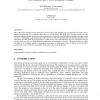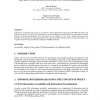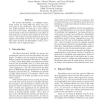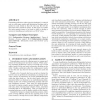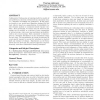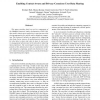UAI
2001
14 years 27 days ago
2001
In previous work [8] we presented a casebased approach to eliciting and reasoning with preferences. A key issue in this approach is the definition of similarity between user prefe...
IADIS
2003
14 years 27 days ago
2003
One of the major challenges facing information systems today is that of finding relevant information to satisfy a user's request and presenting it in a preferred form. The po...
IADIS
2003
14 years 27 days ago
2003
It is sometimes a challenge to untangle the large amount of information on the Web. We thus need to adapt this information to a given user in a particular context. This adaptation...
IADIS
2004
14 years 27 days ago
2004
In this paper, we introduce the concept of "user policies" and its applications to the browsing of HTML documents. The objective of policies is to specify user preferenc...
CATA
2006
14 years 28 days ago
2006
We present Shoechicken, an intelligent agentbased system for rating RSS and Atom news content based on user preferences. The system builds a user profile implicitly by observing a...
DOLAP
2007
ACM
14 years 3 months ago
2007
ACM
Expressing preferences when querying databases is a natural way to avoid empty results and information flooding, and in general to rank results so that the user may first see the ...
GECCO
2009
Springer
14 years 4 months ago
2009
Springer
Optimizing the hypervolume indicator within evolutionary multiobjective optimizers has become popular in the last years. Recently, the indicator has been generalized to the weight...
WPES
2003
ACM
14 years 4 months ago
2003
ACM
The idea of using user preferences to assist with information filtering and with providing the most “relevant” answers to queries has recently received some attention from th...
SIGIR
2003
ACM
14 years 4 months ago
2003
ACM
Collaborative filtering aims at learning predictive models of user preferences, interests or behavior from community data, i.e. a database of available user preferences. In this ...
MDM
2004
Springer
14 years 4 months ago
2004
Springer
This paper provides detail on two key components of the Houdini framework under development at Bell Labs, that enable context-aware and privacy-conscious user data sharing appropr...

